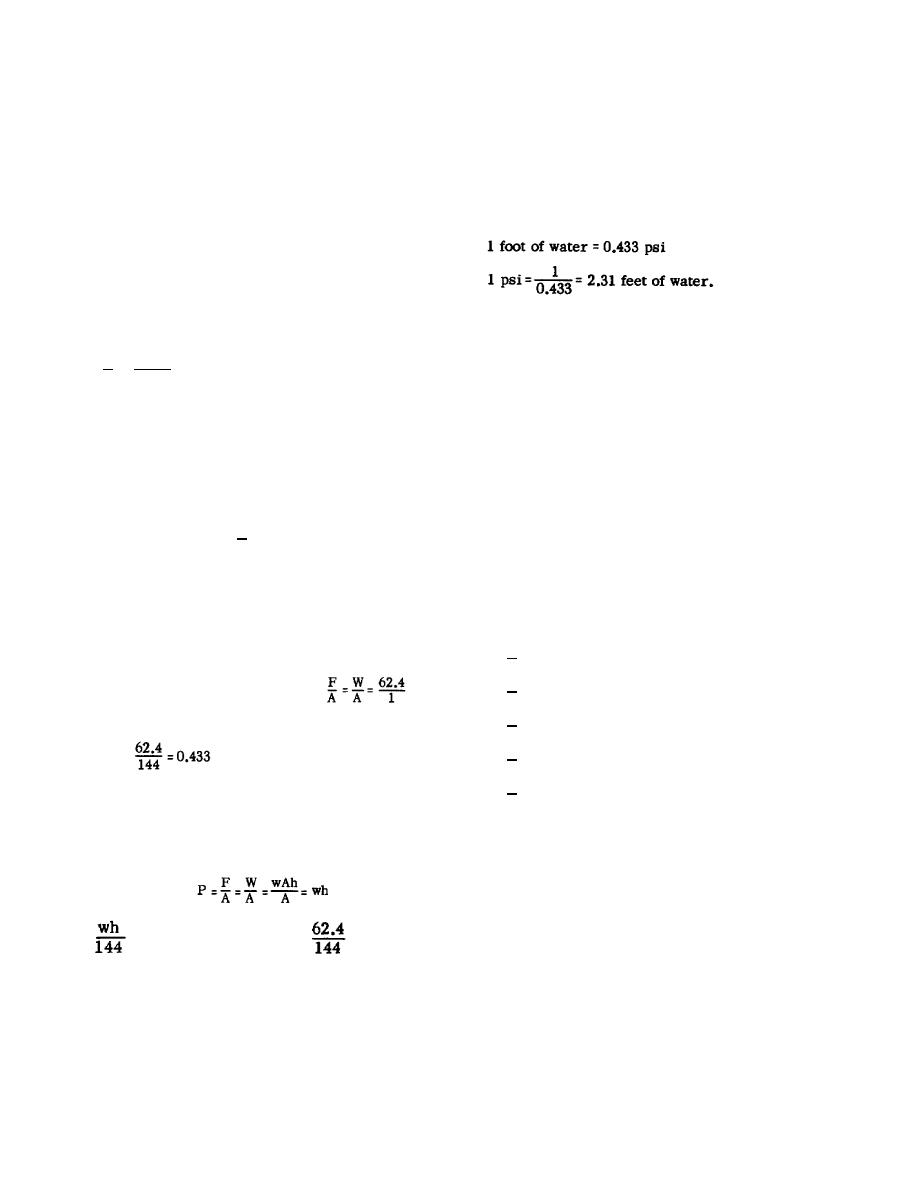
above or below sea level.
Except in
than water, the pressure becomes P =
requiring
extreme
0.433ah where "a" is the specific
accuracy it is assumed to be 14.7
gravity of the fluid (ratio of its
pounds per square inch (psi).
Any
weight to the weight of an equal
time a pressure value is given, some
volume of water).
Since the only
datum value is stated or implied.
In
fluid considered in this course is
water
distribution,
atmospheric
water (specific gravity of 1), the
pressure is used as a datum so that
equations become:
all pressure values given are the
value
above
or
below
atmospheric
pressure.
Any pressure value given
with atmospheric pressure as a base is
called
a
gage
pressure.
All
references to pressure in this course
Thus a column of water 20 feet high
are to gage pressure.
exerts a pressure at the base of (20 x
0.433) = 8.66 psi.
Similarly a
c. Head.
A pressure exists at the
pressure of 20 psi is equivalent to 20
service
connection
(outside
water
x 2.31 = 46.2 feet of water.
This
connection at the building) in a
amount of pressure is available only
gravity
water
distribution
system
if the water is not flowing, since if
because the storage tank is elevated
the water flows some head will be lost
above the building.
The higher the
due to friction.
The design problem
tank above the building the greater
then becomes the choosing of a pipe
the pressure will be. Thus it can be
large
enough
so
that
after
the
seen that there is a relationship
losses
are
removed
the
between difference in elevation and
pressure
left
will
be
enough
to
pressure.
From a above, pressure is
service the building.
defined as the force per unit area.
12. DISTRIBUTION SYSTEM DESIGN
For water under static conditions (no
flow) this force is the weight of the
water and the resultant pressure is
There are generally five steps in the
due to this weight acting on an area.
design of a distribution system:
Since 1 cubic foot of water weighs
62.4 pounds (density = 62.4 pounds per
a. Locate the lines.
cubic foot) the pressure exerted by a
b. Check for excess pressure.
1-foot cube of water is P =
or
62.4
pounds
per
square
foot.
c. Determine peak demand.
Converting to pounds per square inch
d. Calculate allowable headloss.
gives
psi.
Next
consider
a
right
circular
cylinder
of
cross
e. Determine
pipe
size
and
actual
sectional area "A" (square feet) and
headloss.
height "h" (feet), and a fluid of
specific
weight
(weight
per
unit
The last step might be considered to
volume) "w" (pounds per cubic foot).
be two separate steps but they are
The pressure on the base can be
done at the same time and so will be
expressed as
pounds
per
square
considered as one step.
foot.
Converting this to psi gives P
13. LOCATION OF LINES
=
psi.
For water, P =
h=
Topographic maps of the physical location
0.433h, which of course agrees with
of the supply lines and the buildings
the pressure computation for the 1-
foot cube above.
For fluids other
3-14


 Previous Page
Previous Page
